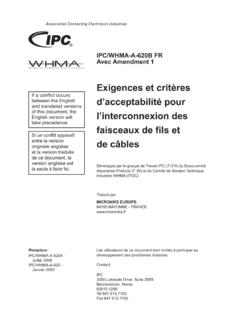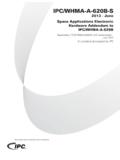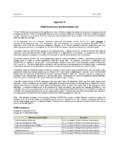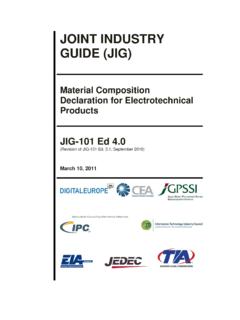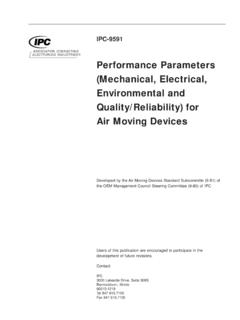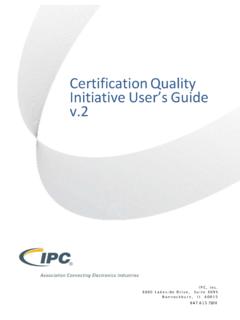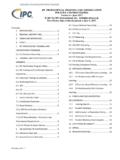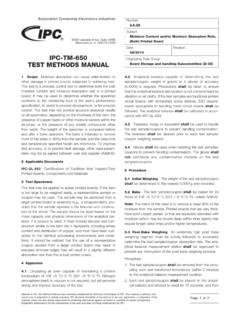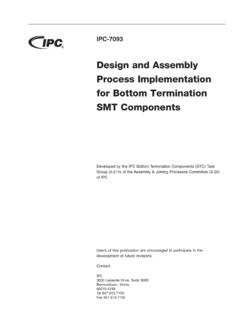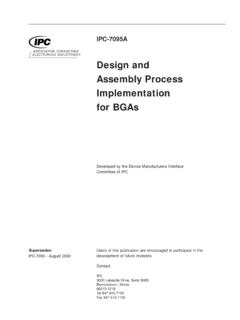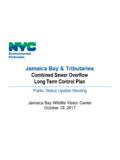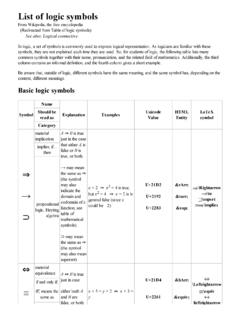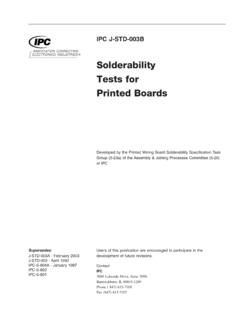Transcription of Solderability Tests for Printed Boards - IPC
1 IPC J-STD-003 CSolderabilityTests forPrinted BoardsDeveloped by the Printed Circuit board Solderability SpecificationsTask Group (5-23a) of the Assembly and Joining Committee (5-20)of IPCU sers of this publication are encouraged to participate in thedevelopment of future :IPC3000 Lakeside Drive, Suite 309 SBannockburn, IL 60015-1249 Phone ( 847) 615-7100 Fax (847) 615-7105 Supersedes:J-STD-003B - March 2007J-STD-003A - February 2003J-STD-003 - April 1992 IPC-S-804A - January 1987 IPC-S-803 IPC-S-801 Table of .. of Requirements .. Hierarchy .. Method Classification .. Acceptance Criteria Tests .
2 Measurement Criteria Tests .. Method Selection .. Surface Finishes Not Covered in 6010or by 4500 Series Documents .. Specimen Requirements .. Durability SnPb Containing(HASL and Plated and Reflowed SnPb)Surface Finishes .. Durability Non-SnPbSurface Finishes .. 42 APPLICABLE .. Industry Standards .. and Definitions .. Angle, Soldering* .. * .. of Component Metallization(Leaching) .. Wetting .. , Solder* .. * .. * .. Connection Pinhole* .. , Solder* .. Removal .. Equipment .. Pot/Bath .. Inspection Equipment .. Equipment .. Equipment .. for Testing.
3 Specimen Preparation and Conditioningfor Test .. Conditioning .. Preconditioning Apparatus .. Conditioning .. Bath Requirements .. Temperatures .. Contamination Control .. 84 TEST Procedure Limitations .. of Flux .. with Established Accept/Reject Criteria .. Dip Test .. Solder Test: .. Mount Simulation Test Tin/LeadSolder .. with Force Measurement Criteria .. Balance Test .. Float Test Tin/Lead Solder .. 175 EVALUATION Aids Surface .. Aids For Class 3 Plated-Through Holes .. for Buoyancy .. Note .. of Nonactivated Flux .. Contact .. 20 APPENDIX ACalculation of MaximumTheoretical Force for aRectangular 21 APPENDIX BCalculation of Area under theWetting 23 APPENDIX CInformative 24 September 2013 IPC J-STD-003 CvAPPENDIX DTest Protocol for Wetting BalanceGauge Repeatability and Repro-ducibility (G R&R) UsingCopper Foil 26 APPENDIX EJ-STD-002/J-STD-003 ActivatedSolderability Test Flux RationaleCommittee 28 FiguresFigure 3-1 Contact Angle.
4 5 Figure 3-2 Example Reticle .. 6 Figure 4-1 Edge Dip Solderability Test .. 9 Figure 4-2 Suggested Test Specimen for Plated-Through Holes .. 10 Figure 4-3 Suggested Test Specimen for SurfaceMount Features .. 10 Figure 4-4 Effectiveness of Solder Wetting of Plated-Through Holes Class 3 below mm .. 12 Figure 4-5 Examples of Solder Wetting of Plated-Through Holes Class 3 below mm .. 12 Figure 4-6 Arrangement for the Test Apparatus (SolderBath Wetting Balance Method) .. 14 Figure 4-7 Arrangement for the Test Apparatus (SolderGlobule Wetting Balance Method) .. 14 Figure 4-8 Suggested Wetting Balance and SolderingImmersion Test Specimens.
5 14 Figure 4-9 Wetting Balance Test Soldering Immersionat 90 for Double Sided Finishes .. 15 Figure 4-10 Wetting Balance Test Soldering Immersionat 20 to 40 for Single Sided Coupons/Samples Removed from PB s .. 15 Figure 4-11 Set A Wetting Curve .. 16 Figure 4-12 Set B Wetting Curve .. 16 Figure 5-1 I Sn Surface Finish Showing UniformWetting .. 18 Figure 5-2 I Sn Surface Finish Showing ChronicDewetting .. 18 Figure 5-3 ENIG Exhibiting Nonwetting .. 18 Figure 5-4 ENIG Exhibiting Nonwetting .. 18 Figure 5-5 ENIG Exhibiting Dewetting .. 19 Figure 5-6 ENIG Exhibiting Dewetting .. 19 Figure 5-7 HASL Surface Finish after Wetting BalanceTesting, showing Excellent Wetting andPositive Advancement of Solder.
6 19 TablesTable 1-1 Solderability Test Method Selection .. 3 Table 1-2 Final Finish Conditioning/ Stress Testing forCategory 3 Durability .. 3 Table 3-1 Flux Composition .. 6 Table 3-2 Steam Temperature Requirements .. 7 Table 3-2 Maximum Limits of Solder Bath Contaminant .. 8 Table 4-1 Stencil Thickness Requirements .. 13 Table 4-2 Reflow Parameter Requirements SnPb .. 13 Table 4-3 Lead-Free Reflow Parameter Requirements .. 13 Table 4-4 Pass/Fail Criteria for Specific SurfaceFinishes Using Eutectic SnPb .. 15 Table 4-5 Pass/Fail Criteria for Specific SurfaceFinishes Using SAC305 Solder .. 16 Table 4-6 Wetting Balance Parameter andSuggested Criteria.
7 16 Table E-1 Flux Compositions .. 28 IPC J-STD-003 CSeptember 2013viSolderability Tests for Printed Boards1 ScopeThis standard prescribes test methods, defect definitions, and illustrations for assessing the Solderability ofprinted wiring board surface conductors, attachment lands, and plated-through holes. This standard is intended for use byboth vendor and standard is not intended to verify the potential of successful processing at assembly or to evaluate design impact onwettability. This specification describes procedures or methods to determine the acceptable wettability of a surface can be affected by handling, finish application, and environmental PurposeThis standard describes Solderability determinations that are made to verify that the Printed board fabricationprocesses and subsequent storage have had no adverse effect on the Solderability of those portions of the Printed boardintended to be soldered.
8 Reference coupons or representative portions of a Printed board may be used. Solderability is deter-mined by evaluation of a test specimen which has been processed as part of a panel of Boards and subsequently removedfor testing per the method ObjectiveTo provide Solderability test methods to determine the acceptance of Printed board surface conductors,attachment lands, and plated-through holes to wet easily with solder, and to withstand the rigors of the Printed board assem-bly Definition of RequirementsThe word shall is used in the text of this document wherever there is a requirementfor materials, preparation, process control.
9 Or acceptance of a soldered connection or a test method. The word should reflects best processing techniques and is used to reflect general industry practices and a suggestion for guidance Document HierarchyIn the event of conflict, the following descending order of precedence applies:a. Procurement documentation as agreed between user and supplier, which should include expected shelf life requirementsif stored and handled Master drawing or master assembly drawing reflecting the user s detailed When required by the customer or per contractual agreement, this document, Other documents, to the extent specified by the ClassificationThree general classes have been established to reflect progressive increases in sophistication, functionalperformance requirements.
10 And testing/ inspection frequency as defined in the IPC-6010 series of user is responsible for defining the product class. The product class should be stated in the procurement 1 General Electronic ProductsIncludes products suitable for applications where the major requirement is function of the completed 2 Dedicated Service Electronic ProductsIncludes products where continued performance and extended life is required, and for which uninterrupted service is desiredbut not critical. Typically the end-use environment would not cause 3 High Performance Electronic ProductsIncludes products where continued high performance or performance-on-demand is critical, equipment downtime cannot betolerated, end-use environment may be uncommonly harsh, and the equipment must function when required, such as lifesupport or other critical board performance classes do not dictate the surface finish durability rating that may be specified.
